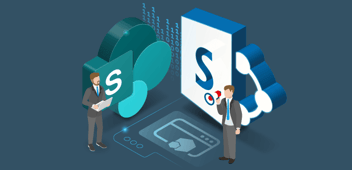Will all samples and tutorials be based on ReactJS or can we expect documentation using other popular frameworks, such as Angular, as well? What is the best way to reuse existing investments in client-side SharePoint solutions implemented using plain JavaScript?
SharePoint Framework ask-me-anything
Recently we had the pleasure of hosting two webinars introducing the SharePoint Framework – a new model for building SharePoint customizations. Bill Baer and Vesa Juvonen from the Microsoft SharePoint Product Group presented the vision behind the SharePoint Framework and how it will help organizations build modern SharePoint solutions.

Recordings and presentations from both webinars are available online at
- Bill Baer: Introduction to development using the SharePoint Framework
- Vesa Juvonen: Deep-Dive to development using the SharePoint Framework
During the webinars you asked Bill and Vesa over 200 questions! While they couldn’t answer all of them during the webinar, we promised you to follow up on them. Following is the first set of questions related to the SharePoint Framework and Bill’s and Vesa’s answers. In this articles series we will share more questions and answers on the topics:
- Part 1: SharePoint Framework Basics
- Part 2: SharePoint Framework Capabilities
- Part 3: SharePoint Framework Developer Tooling
- Part 4: SharePoint Framework Guidance (this post)
Webinar Q&A: SharePoint Framework Guidance
Q4.1 Is there a step-by-step description of how to setup and use the developer machine and how the different pieces fit together?
The SharePoint Framework GitHub repository at https://github.com/SharePoint/sp-dev-docs includes a detailed description of how to setup developer machines and how to work with the SharePoint Framework. This documentation will be kept up-to-date as the SharePoint Framework evolves. If you’re missing something or have feedback feel free to either submit an issue or a pull request in the repository.
Q4.2 Can we expect more guidance and documentation related to working with the SharePoint Framework and Office UI Fabric?
The engineering team is currently working on a series of samples and tutorials that will help developers use the SharePoint Framework. These articles will be released gradually and you should see the first ones being published shortly. In the meanwhile if there are any specific topics you think the engineering team should provide documentation on, please share your idea by submitting an issue in the SharePoint Framework GitHub repository athttps://github.com/SharePoint/sp-dev-docs.
Q4.3 Will all samples and tutorials be based on ReactJS or can we expect documentation using other popular frameworks, such as Angular, as well?
Already there are samples available that illustrate how to build SharePoint Framework Client-Side Web Parts in Angular. You can find them athttps://github.com/SharePoint/sp-dev-fx-webparts/tree/master/samples. In the future you can expect more samples that will illustrate building solutions on the SharePoint Framework using the most popular JavaScript frameworks.
For more information on building SharePoint Framework Client-Side Web Parts with Angular see https://rencore.com/blog/building-sharepoint-framework-client-side-web-parts-angular/.
Q4.4 With the different Web Parts loading different frameworks, how can we ensure that the pages remain highly-performant?
SharePoint Framework offers a number of ways in which you can ensure that your intranet using the different Web Parts built on the SharePoint Framework will remain highly-performant. One of the strategies is to centralize JavaScript frameworks used throughout the intranet, have them stored in an easy-to-access location.
To learn more about optimizing your SharePoint Framework solutions for performance see https://rencore.com/blog/bundling-external-frameworks-sharepoint-framework-client-side-web-parts-bad-idea/.
Q4.5 How can we implement complex HTML templates in Web Parts and what are the trade-offs, if any?
When building Client-Side Web Parts you can choose whether you want to implement the template in-line or in a separate file. Often that depends on how complex the particular template is. By default Client-Side Web Parts use dynamic CSS classes that help developers colliding with other elements on the page. These dynamic classes can only be referenced when the template is included in-line. When working with templates stored in separate HTML files you lose that capability and have to ensure yourself that your classes are not colliding with other classes on the page.
Q4.6 Can the SharePoint Framework be used to develop Outlook Add-ins?
SharePoint Framework is designed for building SharePoint customizations only. For building Office Add-ins developers can leverage the existing Office Add-in model. For more information see http://dev.office.com/getting-started/addins.
Q4.7 What is the best way to reuse existing investments in client-side SharePoint solutions implemented using plain JavaScript?
While the SharePoint Framework encourages using TypeScript it doesn’t require it. With that you should be able to reuse your existing investments and transform them into SharePoint Framework solutions with little effort.
Q4.8 Is the SharePoint Framework ready to be deployed on a production server?
The currently released version of the SharePoint Framework is a developer preview and is not meant to be used in production just yet. We encourage you to try it out and to share your feedback with the engineering team. If you’re building SharePoint customizations today, use the existing SharePoint Add-in model.
Q4.9 In what ways does the SharePoint Framework improve the process of building client-side SharePoint solutions that we’ve been using to date?
SharePoint Framework formalizes the integration of SharePoint customizations with SharePoint. Using the SharePoint Framework developers can more easily build modern solutions that work great both on desktops and mobile devices and which integrate with SharePoint in a robus way that is less-prone to disruptions with the future updates to SharePoint.
Q4.10 What options do I have to use CSS styles with my Web Part?
When building Client-Side Web Parts on the SharePoint Framework you can either choose to include CSS styles in the Web Part bundle generated by the SharePoint Framework tooling or to have your styles published as a separate file and referenced in your Web Part using a URL.
Q4.11 Is there any automated way of transforming SharePoint Add-ins to SharePoint Framework solutions?
At this moment Microsoft doesn’t have any plans for providing an automated way of transforming existing SharePoint Add-ins to SharePoint Framework solutions. Rencore – a Microsoft partner, is currently working on a solution called Transformator that will help organization transform their existing investments to cloud-ready models including the SharePoint Framework. For more information visit: https://rencore.com/products/sptransformator/.
Q4.12 What is the URL for Waldek’s blog which sounds invaluable?
Waldek blogs at https://blog.mastykarz.nl. We also recommend you subscribe to the Rencore blog at https://rencore.com/blog/ where we publish exclusive information and research about SharePoint Framework and SharePoint in general 🙂
Q4.13 When can we expect more information related to building and deploying complete portals using the SharePoint Framework?
Currently the SharePoint Framework is released as a developer preview and is focusing on the developer tooling and experience. As the SharePoint Framework evolves and new capabilities are added you can expect more guidance around structured and repeatable provisioning of SharePoint Framework solutions and leveraging them for building complete portals. Stay tuned for updates.
Q4.14 Many SharePoint Framework tutorials available today are illustrated using Mac. Can we also expect tutorials for Windows users?
SharePoint Framework uses cross-platform toolchain that works exactly the same way on every platform. Even though a particular tutorial might be illustrated using screenshots from Mac, you should be able to follow the exact same steps on Windows or Linux.
Q4.15 Will organizations need to migrate their existing SharePoint Add-ins to the SharePoint Framework?
SharePoint Framework doesn’t deprecate or replace the SharePoint Add-in model and organizations can keep using their existing solutions built using the add-in model for the foreseeable future.
More from Rencore
During the webinars you also asked us some questions.
Can we expect more webinars from Rencore in the future?
Absolutely! Please let us know at marketing@rencore.com what other topics you would be interested in learning more about.
Will the slides, recordings and code samples be shared with attendees?
Slides, recordings and code samples from both webinars are also available on-line at
- Bill Baer: Introduction to development using the SharePoint Framework
- Vesa Juvonen: Deep-Dive to development using the SharePoint Framework
Will Rencore Transformator support the SharePoint Framework?
We are currently investigating ways for transforming existing SharePoint customizations to SharePoint Framework. We will be sharing more information about Transformator and using it with the SharePoint Framework in the near future. In the meanwhile join our new SPTransformator and stay on top of the latest announcements.
One more thing
Once again thank you very much for attending the webinars and all your questions. We are confident that, combined with the answers we got from Bill and Vesa, they offer invaluable insights into SharePoint Framework guidance and will help organizations prepare to benefit of this new model for building SharePoint customizations in the near future.
We hope you enjoyed the webinars and found the answers helpful. If you would like to hear when the next webinar will take place, please sign up for our newsletter. Meanwhile, if you have any more questions related to the SharePoint Framework, please ask in comments and we will do our best to get you an answer.



